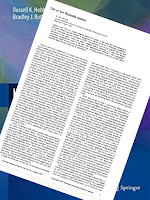The importance of turbulence (nonlaminar) flow is determined by a dimensionless number characteristic of the system called the Reynolds number NR. It is defined by NR = LVρ/η where L is a length characteristic of the problem, V a velocity characteristic of the problem, ρ the density, and η the viscosity of the fluid. When NR is greater than a few thousand, turbulence usually occurs….
When NR is large, inertial effects are important. External forces accelerate the fluid. This happens when the mass is large and the viscosity is small. As the viscosity increases (for fixed L, V , and ρ) the Reynolds number decreases. When the Reynolds number is small, viscous effects are important. The fluid is not accelerated, and external forces that cause the flow are balanced by viscous forces. Since viscosity is a form of internal friction in the fluid, work done on the system by the external forces is transformed into thermal energy. The low-Reynolds-number regime is so different from our everyday experience that the effects often seem counterintuitive. They are nicely described by Purcell (1977).
 |
| “Life at Low Reynolds Number,” by Edward Purcell. |
The video shows a beautiful example of reversibility of low Reynolds number flow. A blob of dye is placed into the fluid between the cylinders, one of the cylinders is rotated, and the dye spreads throughout the fluid. They rotation is then reversed, and the dye eventually returns to its original localized blob. This demonstration always reminds me of the formation of a spin echo during magnetic resonance imaging (see Chapter 18 of IPMB), where all spins begin in phase after a 90 degree radio-frequency magnetic field pulse. Then, because of slight heterogeneities in the static magnetic field, the spins dephase as they all rotate at slightly different Larmor frequencies. If you reverse their positions using a 180 degree RF pulse, the spins eventually return to their original configuration, all in phase (the echo). When you think about it, the formation of spin echoes during MRI is nearly as “magical” as the reformation of the dye blob in Taylor’s cylinder.
The video also analyzes how small machines can “swim” at low Reynolds numbers. He even has built small devices, one a machine that zooms through water but just sits there in a viscous fluid, and another that has a helix for a tail and that swims—slowly but steadily—through the viscous fluid. This example reminds me of both Purcell’s article and the research of Howard Berg, who studies how E coli bacteria swim.
To learn more about Taylor’s life and work, watch Katepalli Sreenivasan’s lecture, or read The Life and Legacy of G. I. Taylor by George Batchelor.



No comments:
Post a Comment